by Candice Hern ©
(click on photos to enlarge image)
VINAIGRETTES
We often read about overwrought ladies reaching for their vinaigrettes, or of
stalwart heroes reviving a swooning damsel by waving a vinaigrette beneath her nose.
Hackneyed as these scenes may sound, they ring quite true in an historical context.
Vinaigrettes, popular from the late 18th century through the mid-19th century, were small containers used
for holding various aromatic substances, usually dissolved in vinegar. A tiny piece of sponge, soaked in the
liquid, was contained beneath a grill or perforated cover.
|
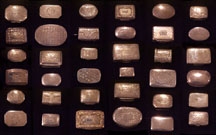 |
| |
a collection of English sterling vinaigrettes 1790-1835
|
By far the most common form of vinaigrette during the Regency was the tiny hinged silver box, and that is
the only type represented in this collection.
One of the ancestors of the vinaigrette was the pomander, which can be traced back at least as far as the
Middle Ages. Pomanders were generally gold or silver, often studded with jewels, and were pierced to allow
the fragrance of the costly solid perfume or aromatic inside to be dispersed.
Unlike liquid perfumes that were often valued for their erotic qualities, the substances contained inside
pomanders were valued more for their medicinal and protective powers against plague and other diseases.
Pomanders were generally spherical, often in the shape of fruit, and were most often worn suspended from a
chain, as a piece of jewelry.
In those days of rampant disease, an orange was often considered a safeguard against infection. Its skin
was saved and wrapped around a vinegar-soaked sponge and carried in the hand.
Henry VIII's advisor, Cardinal Wolsey, is said to have been in the habit of carrying such an orange. At the
Tudor court, however, the aromatic orange was supplanted in popularity by the pouncet box, the more direct
ancestor of the vinaigrette.
Particularly favored by the King himself, the pouncet box was a flattened sphere of gold or gilded silver
with a pierced lid. Inside was a sponge soaked in aromatic vinegar. It was usually hung from the waist with
a silk cord or gold chain.
During the reign of Elizabeth I, the elegant use of the pouncet box, to inhale its sharp fragrance, became
as ritualized a social grace as the taking of snuff some centuries later.

|
|
Sterling vinaigrette with bright-cut decoration on lid and base.
Grill pierced in crude lozenge design.
Joseph Willmore, Birmingham, 1809.
Shown closed, open to grill, and grill opened to show sponge
|
The pouncet box and its variations (the sponge box, the smelling box, the essence box) remained in use
through the 18th century. During the 1770s, more powerful aromatic vinegars were developed, with a strong
acetic acid base and concentrated perfumed oils.
The intensity of the aromatics resulted in a drastic reduction in the size of the containers which held
them, now called aromatic vinegar boxes. The term vinaigrette came into general use during the 1780s.
The vinaigrette was used by both men and women at this time, though by the 1820s it was almost exclusively a
feminine accessory. Carried in a pocket or reticule, or suspended from a chatelaine at the waist, it was
used to mask unsanitary odors and for direct inhalation of its restorative vapors.
Since one never knew when emotion or tight lacing would overcome one, the vinaigrette needed to be near at
hand and its aromatics quickly accessible. The hinged lid allowed it to be flipped open, like a snuff box,
with the flick of a finger.
Top: Large sterling vinaigrette with bright-cut diaper pattern on
lid and base, and a central medallion on lid monogrammed "MAW". Engraved and pierced grill
echoes exterior diaper design. Thomas Phipps & Edward Robinson, London, 1801.
Bottom: Sterling vinaigrette with bright-cut floral decoration on lid and base, and uncut
central medallion for monogram. Grill engraved and pierced in scroll pattern. Edward
Smith, Birmingham, 1835
|
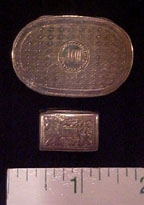 |
Compared to its larger and heavier ancestors, the vinaigrette was a tiny, delicate box --generally no more
than 1 or 1 1/2 inches in width. Figure 3 shows both the largest and smallest vinaigrettes in my collection,
with a ruler as reference. Approximately 90% of all English silver vinaigrettes were produced in Birmingham.
The sterling interiors were gilded to prevent discoloration from the acetic acid, which did not affect gold.
Though most vinaigrettes were alike in construction, the silversmiths used all their decorative skill to set
one apart from the other. When one considers the minute dimensions of the vinaigrette, those skills are
impressive indeed.
There were simple, elegant, plain exteriors. Others had chased, engraved, engine-turned, or applied cast
decoration. A great many of them were monogrammed (see Figure 5), sometimes with the initials of both the
giver and recipient in a presentation inscription. The lids were sometimes decorated to commemorate
important events, eg the death of Lord Nelson in 1805.
By the 1830s it had become fashionable to depict specific houses or churches or other famous structures on
the lid through engraving or press-embossing.
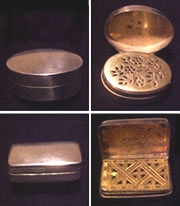 |
Top: Sterling vinaigrette in plain, undecorated case. Grill
punched with floral design. Thomas Willmore, Birmingham, 1801.
Bottom: Sterling vinaigrette in plain, undecorated case. Grill pierced and bright-cut in
a geometric design. Joseph Willmore, Birmingham, 1805.
|
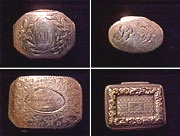 |
Top left: Sterling vinaigrette with bright-cut floral
decoration on lid and simple geometric border on base. Central medallion on lid
monogrammed 'ASN'. Grill pierced in simple lozenge design. Matthew Linwood, Birmingham,
1808.
Top right: Sterling vinaigrette in plain, undecorated case. Presentation
inscription 'SP to FP' engraved on lid. Grill pierced in simple lozenge design. Thomas
Willmore, Birmingham, 1799.
Bottom left: Sterling vinaigrette with bright-cut patterns of curls and waves of
lid and floral medallion on base. Central medallion on lid monogrammed 'H Rushworth'.
Grill pierced with flower design. Samuel Pemberton, Birmingham, 1814.
Bottom right: Sterling vinaigrette with chased floral border on lid, surrounding
engine-turned basketweave pattern, repeated on base. Central medallion on lid engraved
with presentation inscription 'HN to EN'. Samuel Pemberton, Birmingham, 1817.
|
Not all vinaigrettes were shaped as simple ovals and rectangles. Various novelty shapes were popular,
especially the wallet or satchel and the shell. They also came in the shape of books, nuts, eggs, watches, crowns, hearts, etc. Regardless of shape, the
typical vinaigrette of the English Regency period was hinged and opened to reveal a grill.

|
|
Left: Sterling vinaigrette in the shape of a wallet,
with bright-cut floral decoration on lid and base. Grill pierced and engraved with
rose and thistle design. A suspensory loop is contemporary with the original
manufacture, and indicates the vinaigrette would have been worn on a chain as a locket
or as part of a chatelaine. Maker unknown, Birmingham, 1816.
Center: Sterling vinaigrette in the shape of a wallet, with chased floral
border on sides, and bright-cut decoration on lid and reverse. Grill pierced and
engraved with a basket of flowers. Joseph Taylor, Birmingham, 1818.
Right: Sterling vinaigrette in the shape of a wallet, with bright-cut decoration
in imitation of animal skin. Grill pierced and engraved with floral design. John Shaw,
Birmingham, 1818. |
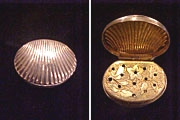
|
|
Sterling vinaigrette in shell form, shown open and closed.
Grill pierced and engraved in floral pattern.
John Shaw, Birmingham, 1812 |
The grills display as much diversity of decoration as the exteriors. The earliest
vinaigrettes often have only a simple punched grill
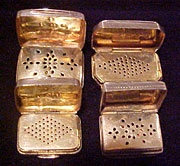 |
Top left: Sterling vinaigrette with bright-cut basketweave pattern surrounding empty
monogram square on lid, simple floral design on reverse. Grill punched in simple
geometric pattern. John Bettridge, Birmingham, 1794.
Top right: Sterling vinaigrette with simple bright-cut border and central medallion
monogrammed "EP". Grill pierced in simple lozenge pattern. Maker unknown, London, 1799.
Bottom left: Sterling vinaigrette with crude bright-cut decoration and monogrammed "SJ" on
lid. Grill pierced in simple lozenge pattern. Matthew Linwood, Birmingham, 1807.
Bottom right: Sterling vinaigrette with bright-cut decoration in wave pattern on lid and
floral design on base. Lid monogrammed "TM". Grill punched in simple geometric pattern.
Joseph Bettridge, Birmingham, 1796. |
During the Regency the grills became more elaborate with intricate scrollwork, flowers,
foliage, or other complex decorative designs.
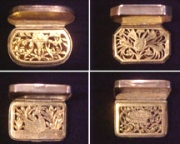 |
Top left: Sterling vinaigrette with plain case decorated only with a tiny
bright-cut border. Grill punched and engraved in a tussy-mussy design. John Shaw,
Birmingham, 1816
Bottom left: Sterling vinaigrette with a bright-cut floral design on lid and plain
base. Lid monogrammed "EW". Grill punched and engraved with swimming swan design.
Matthew Linwood, Birmingham, 1812.
Top right: Sterling vinaigrette with simple, unengraved monogram medallion on lid
and starburst design on base. Grill punched and engraved with a floral design surrounding
a lute and sheets of music. John Bridge, London, 1800.
Bottom right: Sterling vinaigrette with bright cut decoration on lid in diaper
pattern, and floral design on base. Grill punched and engraved in a scroll pattern
surrounding a basket of fruit. Matthew Linwood, Birmingham, 1808 |
Another popular type of grill was the filigree or wirework design .
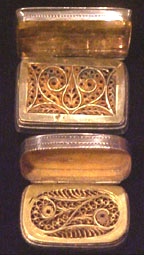 |
Top: Sterling vinaigrette with bright-cut floral decoration on lid and base.
Grill is punched and tooled to simulate wirework. Joseph Willmore, Birmingham, 1824.
Bottom: Sterling vinaigrette with bright-cut decoration on lid in a geometric
pattern, and on the base in a floral pattern. Grill is true wirework in a delicate
filigree pattern. Joseph Taylor, Birmingham, 1801. |
Though my own vinaigrette collection is exclusively silver (I appreciate the ease of
dating via the required hallmarks), other materials were also used, including gold, and
some were even decorated with jewels. After 1820, the lid might be made of polished
agate, carnelian, onyx, or other stone.
Vinaigrettes reached their peak of popularity during the Regency, and often became incorporated into other
objects, like scent bottles, snuff boxes, and jewelry.
 |
 |
|
Cut crystal scent bottle, c. 1815.
Inset vinaigrette with lid of woven hair
under glass, and grill pierced and engraved
in starburst design. |
Gold vinaigrette ring, c. 1820.
Rock crystal lid and lattice grill. |
By the 1840s, vinaigrettes had declined in popularity, being associated with matrons and
dowagers. They continued to be incorporated into Victorian double-ended scent bottles, but
by mid-century, the charming little silver boxes had become a relic of past generations.
SOURCES
Sarah Coe, "Vinaigrettes and Other Personal Silver," The Antiquarian, November 1930.
Genevieve Cummins and Nerylla Taunton, Chatelaines, Antique Collectors’ Club, 1994.
Eric Delieb, Silver Boxes, Exeter Books, 1979.
Eileen Ellenbogen, English Vinaigrettes, Golden Head Press, 1956.
Kate Foster, Scent Bottles, The Connoisseur, 1966.
Annette Green and Linda Dyett, Secrets of Aromatic Jewelry, Flammarion, 1988.
G. Bernard Hughes, Antique Small Silverware, Bramwell House, 1957.
William I. Kaufman, Perfume, Dutton, 1974.
Edmund Launert, Scent & Scent Bottles, Barrie & Jenkins, 1974.
Heiner Meininghaus and Christa Habrich, Five Centuries of Scent and Elegant Flacons, Arnoldsche, 1998.
Alexandra Walker, Scent Bottles, Shire Publications, 1996.
|
|
|
|
 ASSOCIATION OF SMALL COLLECTORS OF ANTIQUE SILVER
ASSOCIATION OF SMALL COLLECTORS OF ANTIQUE SILVER










